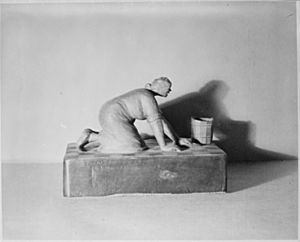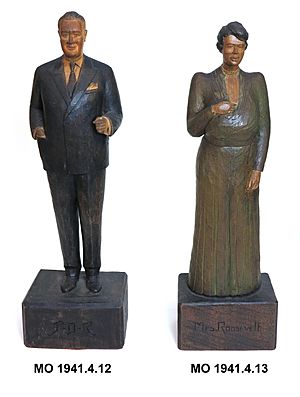Leslie Garland Bolling facts for kids
Quick facts for kids
Leslie Bolling
|
|
|---|---|

Leslie Bolling preparing a rough block of wood for carving
|
|
| Born |
Leslie Garland Bolling
September 16, 1898 |
| Died | September 27, 1955 (aged 57) New York City
|
| Resting place | Woodland Cemetery, Richmond, Virginia |
| Education | Hampton Agricultural and Normal Institute (1916–1918) Virginia Union University (?–1924) |
| Alma mater | Virginia Union University |
| Occupation | Sculptor |
| Years active | 1928–1950 |
| Known for | Wood carving |
|
Notable work
|
Days of the Week Red Cap |
| Spouse(s) |
Julia V. Lightner
(m. 1928)Ethelyn M. Bailey
(m. 1948) |
Leslie Garland Bolling (born September 16, 1898 – died September 27, 1955) was a talented sculptor. He was born in Surry County, Virginia, USA. His father, Clinton C. Bolling, was a blacksmith. Leslie Bolling's artwork showed scenes from daily life. His carvings shared the values of Black culture in the southern United States during the early 1900s. Bolling was part of the Harlem Renaissance. He is known as one of the few African-American sculptors whose work became famous and lasted.
Early Life and Education
Leslie Bolling was born in Dendron, Virginia. This was a small town in Surry County, Virginia. His father, Clinton C. Bolling, worked as a blacksmith.
From 1916 to 1918, Leslie went to Hampton Normal and Agricultural Institute. Today, this school is called Hampton University. It was a place where African-American young people could get a good education. This helped them improve their lives. Bolling did not have any special art training there.
In 1919, he joined Virginia Union University in Richmond, Virginia. This was a historically black university. During this time, there were many race riots across the country. Bolling took regular classes there. He also took a class called Manual Training. This class taught him freehand drawing and how to use tools. He learned to work with wood and iron.
After finishing college in 1924, Bolling started working. He became a porter at a stationery store. A porter is someone who carries things or helps customers. In 1928, he married Julia V. Lightner. They did not have any children.
Becoming an Artist
Bolling grew up near places where trees were cut for wood. He said he was always around trees. He really enjoyed whittling, which is carving wood with a small knife. This hobby gave him lots of practice with different kinds of wood.
His carving was a fun and somewhat profitable hobby. But he always saw himself as a porter first. His hobby became more serious around 1928. He made some early figures for an art show. This show was put on by the YWCA.
These first carvings caught the eye of Carl Van Vechten. He was a supporter of the Harlem Renaissance art movement. Around 1931, Bolling started teaching wood carving. He taught black youth in Richmond. He taught at the Craig House Art Center until 1941.
By 1938, Bolling and others got help from the WPA. The WPA was a government program during the Great Depression. It helped people find jobs, including artists. The Craig House became the only WPA art center in the South for black youth.
His art became more widely known after 1933. That year, he showed his work at the National Negro Exhibition at the Smithsonian. From 1934 to 1940, Bolling's art was part of several tours. These tours were organized by the William E. Harmon Foundation. They helped show the art of African-Americans.
In January 1935, Bolling had a special honor. The Academy of Arts in Richmond held a show just for his carvings. This museum is now the Virginia Museum of Fine Arts. At that time, the museum was segregated. After this, he had a show at the New Jersey state museum. A famous painter named Thomas Hart Benton saw his work. He said Bolling's sculptures "show real merit, and a new kind of form."
In 1936, Bolling showed his art at the Texas Centennial Exhibition. In June 1937, he had another show in New York. This show featured 17 pieces. It included his series of sculptures called Days of the Week. He had started this series in 1933.
In 1940, a writer named Alain Locke included a photo of Bolling's work in his book, The Negro in Art. Bolling also carved a bust of the famous singer Marian Anderson. He made it after she performed in Richmond.
In 1942, Bolling won a competition. It was sponsored by Science and Mechanics magazine. The last known show of his work during his life was in 1950. It was at the State Teachers College at Indiana. This school is now Indiana University of Pennsylvania.
Bolling's sculptures were featured in books about African-American art. In 2006, the Library of Virginia held an exhibit of his work. They showed information about 30 of his pieces.
Later Life
In the early 1940s, Bolling left Richmond. He moved to Pennsylvania. In 1948, he married Ethelyn M. Bailey. She was his second wife. After moving to New York City, his art was shown by the Cox Gallery. Leslie Bolling passed away in New York on September 27, 1955. His body was brought back to Richmond, Virginia, for burial.
Famous Sculptures
Experts believe Leslie Bolling carved between 50 and 80 pieces. He was active as an artist for about twenty years. Sadly, many of his sculptures have been lost. In 2006, the Library of Virginia could only find 30 of his wood sculptures.
Here are some of his well-known sculptures:
- Days of the Week: This is a series of seven sculptures. He made them between 1932 and 1937. They show typical weekly activities of African-Americans. Three of these sculptures are currently missing.
- Aunt Monday: Shows a woman doing laundry in a big wooden tub.
- Sister Tuesday: Shows a woman ironing clothes.
- Mama on Wednesday: Shows a woman sewing and fixing clothes.
- Gossip on Thursday: Shows two women talking over a fence.
- Cousin on Friday: Shows a woman scrubbing floors.
- Cooking on Saturday: Shows a woman pulling a turkey from an oven. This turkey was likely for Sunday dinner.
- Parson on Sunday: Shows a male preacher speaking from his pulpit.
- Fish Man (1935): Shows a fish seller walking. He is looking for customers.
- Red Cap (1937): Shows a porter moving luggage.
- At Work (1937): This might be a self-portrait. It shows a man hammering a wooden cart.
- Marian Anderson (1940): A sculpture of the famous singer's head and shoulders.
- President and Mrs. Franklin D. Roosevelt (1940): Two carvings showing the President and First Lady.
- Woman Cooking (1942): Shows a woman picking up a coffee pot from a stove.




